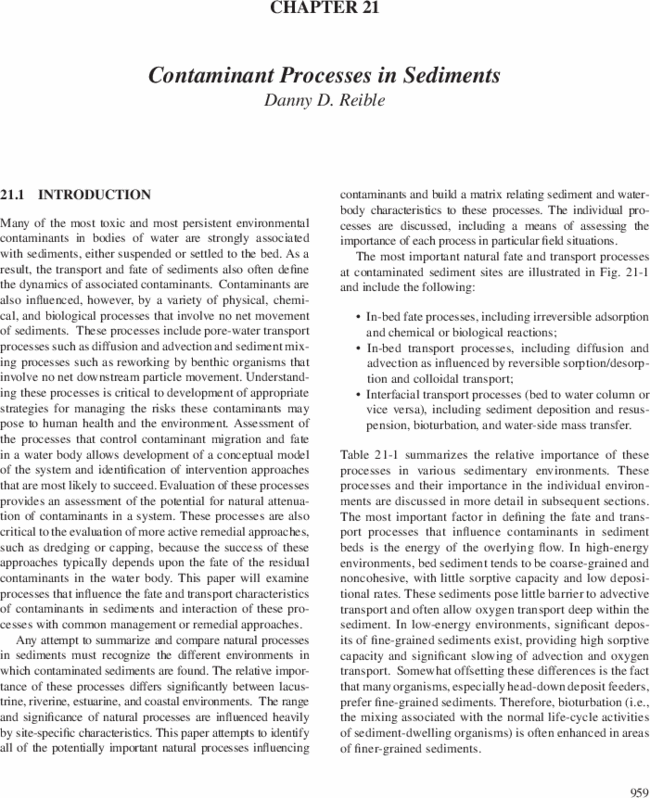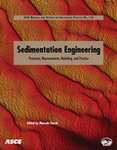Chapter 21
Containment Processes in Sediments
Publication: Sedimentation Engineering: Processes, Measurements, Modeling, and Practice

Get full access to this article
View all available purchase options and get full access to this chapter.
REFERENCES
Aller, R. C. (1982). “The effects of macrobenthos on chemical properties of marine sediments and overlying water.” Animal sediment relations, McCall R.L. and Tevasz M.I.S., eds., Plenum, New York.
Blasland, Bouck & Lee (BBL). (1996). “St. Lawrence River Sediment Removal Project Remedial Action Completion Report.” Prepared for General Motors Powertrain, Massena, New York, Blasland, Bouck & Lee, Syracuse, N.Y.
Blasland, Bouck & Lee (BBL). (2000). “Fox River Dredging Demonstration Projects at Sediment Deposit N and Sediment Management Unit 56/57.” For River Group, Blasland, Bouck & Lee, Syracuse, N. Y.
Boudreaux, B. P. (1986a). “Mathematics of tracer mixing in sediments. I: Spatially-dependent, diffusive mixing.” American Journal of Science 286, 161.
Boudreaux, B. P. (1986b). “Mathematics of tracer mixing in sediments. II: Nonlocal mixing and conveyor belt phenomena.” American Journal of Science 286,199.
Brown, J. F., et al. (1984). Northeast environment science 3, 167.
Brownawell, B. J. (1986). “The role of colloidal organic matter in the marine geochemistry of PCB.” PhD dissertation. WHO1-8619-19, Woods Hole Oceanographic Institution, Woods Hole, Mass.
Cheng, N. S. (1997). “Simplified settling velocity formula for sediment particle.” Journal of Hydraulic Engineering, ASCE 108(12), 1486–1503.
Cornett, R. J. (1989). “Measuring groundwater transport through lake sediments by advection and diffusion.” Water Resources Research 25, 1815.
Das, B. M. (1979). Introduction to soil mechanics. Iowa State University Press, Ames, Iowa.
Davison, C. (1891). “On the amount of sand brought up by lob worms to the surface.” Geological magazine 8, 489.
DiGiano, F. A., Miller; C. T., and Yoon, J. (1993). “Predicting release of PCBs at point of dredging.” Journal of Environmental Engineering, ASCE 119(19), 72–89.
DiGiano, F. A., Miller, C. T., and Yoon, J. (1995). Dredging elutriate test development. U.S. Army Engineer Waterways Experiment Station, Vicksburg, Miss.
Elliot, A. H., and Brooks, N. H. (1997a). “Transfer of nonsorbing solutes to a streambed with bed forms: Theory.” Water Resources Research 33(1), 123–136.
Elliot, A. H., and Brooks, N. H. (1997b). “Transfer of nonsorbing solutes to a streambed with bed forms: Laboratory experiments.” Water Resources Research 33(1), 137–151.
Foth & Van Dyke (2000). “Summary Report: Fox River Deposit N.” Wisconsin Department of Natural Resources Madison, N.J.
Foth & Van Dyke. (2001). “Final Report 2000 Sediment Management Unit 56/57 Project Lower Fox River, Green Bay, Wisconsin.” Prepared for United States Environmental Protection Agency, Wisconsin Department of Natural Resources.
Hayes, D. F., Crockett, T. R., Ward, T. J., and Averett, D. (2000). “Sediment resuspension during cutterhead dredging operations.” Journal of Waterway, Port, Coastal, and Ocean Engineering 126(3), 153–161.
Hickey, J. J., et al. (1966). “An exploration of pesticides in a Lake Michigan ecosystem.” Journal of Applied Ecology 3, 141–154.
Huang, W., and Weber, W. J. Jr. (1997). “A distributed reactivity model for sorption by soils and sediments. 10: Relationships between desorption, hysteresis, the chemical characteristics of organic domains.” Environmental Science and Technology 31(9), 2562–2569.
Hughes, J. B., Beckles, D. M., Chandra, S. D., and Ward, C. H. (1997). “Utilization of bioremediation processes for the treatment of PAH-contaminated sediments.” Journal of Industrial Microbiology and Biotechnology 18, 152–160.
Hunter, M. A., Kan, A. T., and Tomson, M. B. (1996). “Development of a surrogate sediment to study the mechanisms responsible for adsorption/desorption hysteresis.” Environmental Science 30, 1996.
Ingersoll, C. G., Dillon, T., and Biddinger, G. R. (1997). Ecological risk assessment of contaminated sediments, SETAC Press, Pensacola, Fla.
Jones, C., and Lick, W. (2000). “Effects of Bed Coarsening on Sediment Transport.” Estuarine and Coastal Modeling, Proceedings of the Sixth International Conference, ASCE, Reston, Va., 915–993.
Kan, A. T., Fu, G., Hunter, M. A., Chen, W., Ward, C.H., and Tomson, M. B. (1998). “Irreversible sorption of neutral hydrocarbons to sediments: Experimental observations and model predictions.” Environmental Science and Technology 32(7), 892–902.
Kan, A. T., Fu, G., Hunter, M. A., and Tomson, M. B. (1997). “Irreversible adsorption of naphthalene and tetraclorobiphenyl to lula and surrogate sediments.” Environmental Science and Technology 31, 2176–2185.
Lick, W., and Lick, J. (1988). “Aggregation and disaggregation of fine-grained lake sediments.” Journal of Great Lakes Research 14(4), 514–523.
Matisoff, G. (1982). “Chapter 7: Mathematical models of bioturbation.” Animal sediment relations, McCall R.L. and Tevasz M.I.S., eds., Plenum, New York.
McGroddy, S. E., and Farrington, J. W. (1995). “Sediment pore-water partitioning of polycyclic aromatic hydrocarbons in three cores from Boston Harbor, Massachusetts.” Environmental Science and Technology 29, 1542—1550.
McNeill, J., Taylor, C., and Lick, W. (1995). “Measurements of erosion of undisturbed bottom sediments with depth.” Journal of Hydraulic Research 12(4), 361–369.
Millington, R. J., and Quirk, J. M. (1961). “Permeability of porous solids.” Transactions of the Society 57, 1200–1207.
Myers, T. E., et al. (1996). “Estimating contaminant losses from components of remediation alternatives for contaminated sediments.” EPA 905-R96-001, U.S. Environmental Protection Agency, Washington, D.C.
National Research Council (NRC). (2001). A Risk-Based Framework for the Management of PCB Contaminated Sediments, National Research Council, Washington, D.C.
Palermo, M. R., Maynord, S., Miller, J., and Reible, D. D. (1998). “Guidance for in situ subaqueous capping of contaminated sediments.” US Epa 905-B96-004, Assessment and Remediation of Contaminated Sediments (ARCS) Program, Great Lakes National Program Office, U.S. Environmental Protection Agency, Chicago.
Pereira, W. E., Rostad, C. E., Chiou, C. T., Brinton, T. I., and Barbar, L. B., II. (1988). “Contamination of estuarine water, biota, and sediment by halogenated organic compounds: A field study.” Environmental Science and Technology 22, 772–778.
Pignatello, J. J., and Xing, B. (1996). “Mechanisms of slow sorption of organic chemicals to natural particles.” Environmental Science and Technology 30, 1–11.
Readman, J. W., and Mantoura, R. F. C. (1987). “A record of polycyclic aromatic hydrocarbon (PAH) pollution obtained form accreting sediments of the Tamar Estuary U.K.: Evidence for non-equilibrium behaviour of PAH.” Science of the Total Environment 66, 73–94.
Reible, D. D., Valsaraj, K. T., and Thibodeaux, L. J. (1991). “Chemodynamic models for transport of contaminants from sediment beds.” Handbook of Environmental Chemistry, Hutzinger O., ed., Springer, Heidelberg, 187–228.
Reible, D. D., et al. (1996). “Contaminant fluxes from sediment due to tubificid oligachaete bioturbation.” Water Research 30(3), 704.
Rhoads, D. C. (1974). “Organism sediment relations on the muddy sea floor.” Oceanography and Marine Biology Annual Review 12, 263.
Savant, S. A., Reible, D. D., and Thibodeaux, L. J. (1987). “Modeling convective transport in stable river sediments.” Water Resources Research 23, 1763.
Savant-Malhiet, S. A., and Reible, D. D. (1993). “Comparison of physical transport processes in river sediments.” Journal of Environmental Engineering, ASCE 119(1), 90–102.
Science Advisory Board (SAB). (1995). “Review of the agency’s approach for developing sediment criteria for five metals.” EPA-SAB-EPEC-95-020, U.S. Environmental Protection Agency Science Advisory Board, Washington, D.C.
Spaulding, M. L. (1987). “Selected studies on PCB transport in New Bedford Harbor.” ASA 86-18, Applied Science Associates, Narragansett, R.I.
Stark, T. D. (1991). “Program documentation and user’s guide: PCDDF89, Primary consolidation and dessication of dredged fill.” Instruction Report D-91-1, U.S. Army Engineers Waterways Experiment Station, Vicksburg, Miss.
Thibodeaux, L. J. (1989). “A theoretical evolution of the effectiveness of capping PCB contaminated New Bedford Harbor sediment.” Project No. 629201. Louisiana State University Report to Balsam Environmental Consultants.
Thibodeaux, L. J. (1996). Environmental chemodynamics. Wiley, New York.
Thibodeaux, L. J., and Boyle, J. O. (1987). “Bedform-generated convective transport in bottom sediment.” Nature 325 (6102), 341.
Thibodeaux, L. J., Reible, D. D., and Valsaraj, K. T. (1999). Effectiveness of environmental dredging. Final Report to Alcoa, Massena, NY, Hazardous Substance Research Center/South and Southwest, Louisiana State University, Baton Rouge.
Thibodeaux, L. J., Valsaraj K. T., and Reible, D. D. (2001). “Bioturbation-driven transport of hydrophobic organic contaminants from bed sediment.” Environmental Engineering Science 18(4), 215–223.
Thoma, G. J., Koulermos, A. C., Valsaraj, K.T., Reible, D. D., and Thibodeaux, L. J. (1991). “Chapter 13: The effects of pore water colloids on the transport of hydrophobic organic compounds from bed sediment.” Organic Substances in Soils and Sediments, Baker R.A., ed., Lewis, Boca Raton, Fla., 231–250.
Thoma, G. J., Reible, D. D., Valsaraj, K. T., and Thibodeaux, L. J. (1993). “Efficiency of capping contaminated sediments in situ. 2: Mathematics of diffusion-adsorption in the capping layer.” Environmental Science and Technology 27(12), 2412–2419.
Thoms, S. R., Matisoff, G., McCall, P. L., and Wang, X. (1995). “Models for alteration of sediments by benthic organisms.” Final Report Project 92-NPS-2, Water Environment Research Foundation, Alexandria, Va.
Tiedge, J. M., Quenson, J. F., Chee-Sanford, J., Schimel, J. P., and Boyd, S. A. (1993). “Microbial reductive dechlorination of PCBs.” Biodegradation 4(4), 231–240.
Transportation Research Board. (1970). “Tentative design procedure for riprap-lined channels.” Report 108, National Academy of Sciences, National Cooperative Highway Research Program, Washington, D.C.
U.S. Army Corps of Engineers (USACE). (1990). “New Bedford Harbor superfund pilot study: Evaluation of dredging and dredged material disposal.” U.S. Army Corps of Engineers, New England Division, Concord, Mass.
U.S. Bureau of Reclamation (USBR). (1973). Design of small dams, 2nd Ed. U.S. Bureau of Reclamation, Washington, D.C.
U.S. Environment Protection Agency (USEPA). (1993a). “Biological and chemical assessment of contaminated Great Lakes sediment.” EPA 905-R93-006, U.S. Environmental Protection Agency, Washington, D.C.
U.S. Environment Protection Agency (USEPA). (1993b). “Technical basis for deriving sediment quality criteria for nonionic organic contaminants for the protection of benthic organisms by using equilibrium partitioning.” EPA 822-R-93-011, U.S. Environmental Protection Agency, Washington, D.C.
U.S. Environment Protection Agency (USEPA). (1994). “Assessment guidance document.” EPA 905-B94-002, U.S. Environmental Protection Agency, Washington, D.C.
Valsaraj, K. T., Thibodeaux, L. J., and Reible, D. D. (1997). “A quasi-steady state pollutant flux methodology for determining sediment quality criteria.” Environment Toxicology and Chemistry 16(3), 391.
Vittal, N., Rangu Raju, K. G., and Garde, R. J. (1977). “Resistance of two-dimensional triangular roughness.” Journal of Hydraulic Research, ASCE 15(1), 19.
Wang, X. Q., Thibodeaux, L. J., Valsaraj, K. T., and Reible, D. D. (1991). “The efficiency of capping contaminated sediments in situ. I: Lab-scale experiments of diffusion/adsorption in the capping layer.” Environmental Science and Technology 25(9), 1578–1584.
White, J. C., Hunter, M., Nam, K., Pignatello, J. J., and Alexander, M. (1999). Environmental Toxicology and Chemistry 18, 1720–1727.
Wisconin Department of Natural Resources (WDNR). (2001). “Draft feasibility study—Lower Fox River and Green Bay, Wisconsin.” Wisconsin Department of Natural Resources, Madison.
Zhang, X. M., and Young, L. Y. (1997). “Carboxylation as an initial reaction in the anaerobic metabolism of naphthalene and phenanthrene by sufidogenic consortia.” Applied Environmental Microbiology 63(12), 4759–4764.
Information & Authors
Information
Published In
Copyright
© 2008 American Society of Civil Engineers.
History
Published online: May 6, 2013
ASCE Technical Topics:
Authors
Metrics & Citations
Metrics
Citations
Download citation
If you have the appropriate software installed, you can download article citation data to the citation manager of your choice. Simply select your manager software from the list below and click Download.
